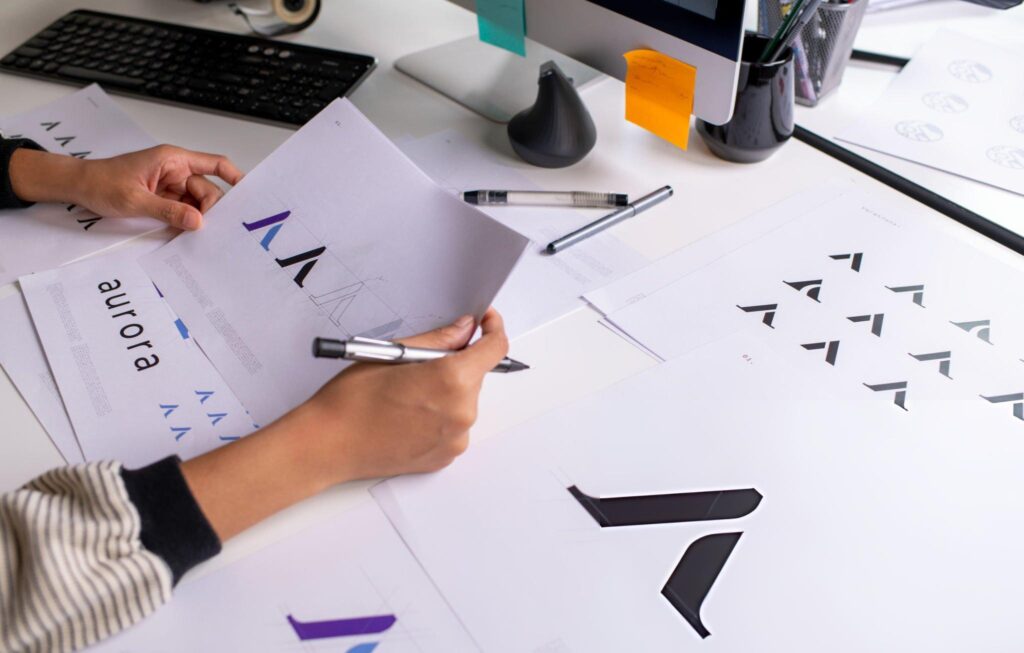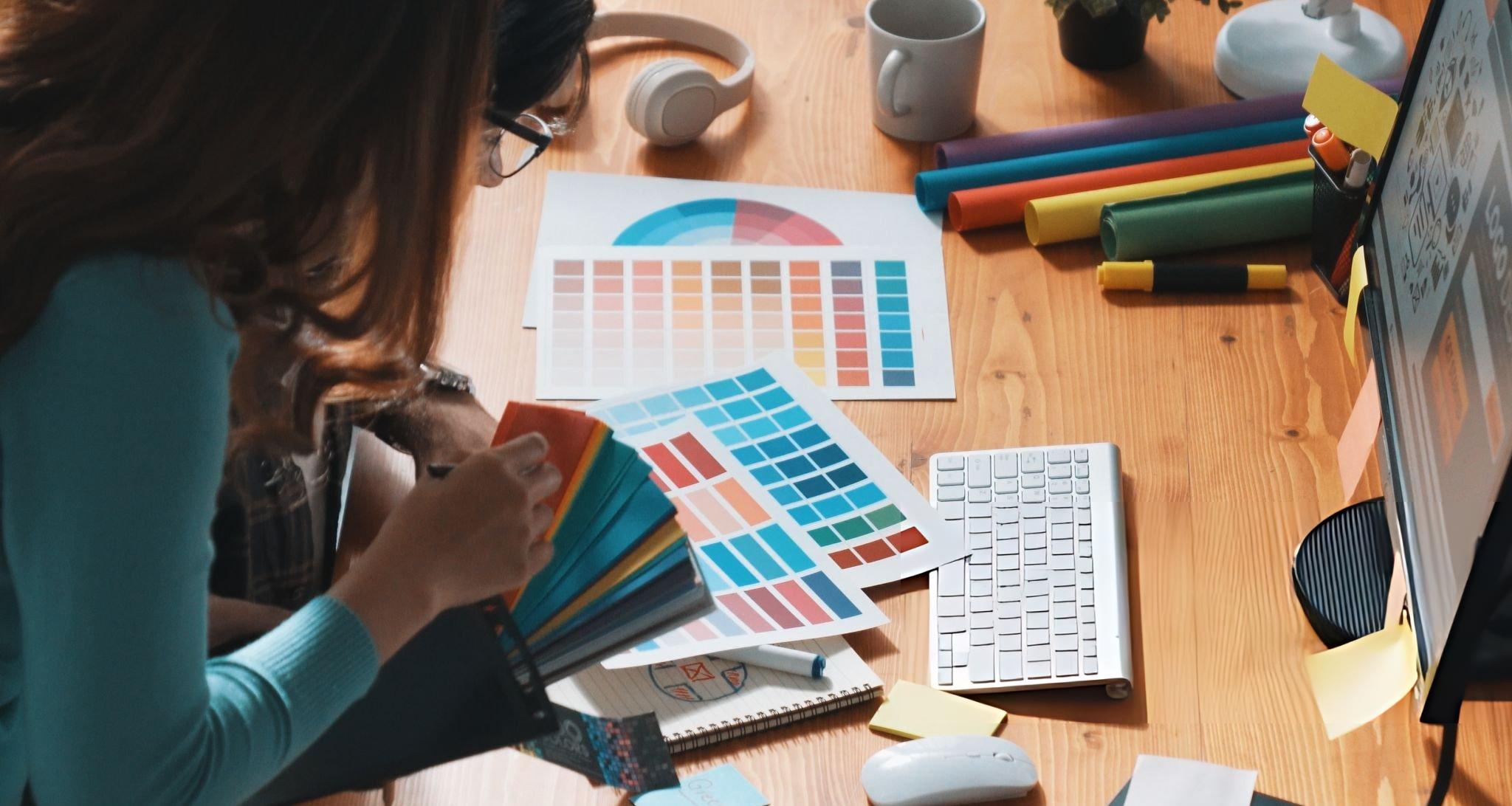Logo design isn’t just about a cool looking logo—it’s a crucial part of your business’s branding strategy and it is often the first interaction people have with your business. A well-designed logo conveys your brand’s story, company values, and professionalism, and helps with brand recognition. In fact, according to Marketing Scoop, 75% of people can recognize a brand by its logo alone, highlighting the powerful impact logos have on brand recognition and customer recall. This article explains why effective logo design is essential, especially for small to medium sized businesses, and how it plays a pivotal role in building a recognizable…and successful brand!
Logo and Design Marketing Basics
 Logos serve as a significant component in shaping consumer perceptions and behaviors, playing an important role far beyond their aesthetic appeal. They can evoke emotional responses that influence purchasing decisions and brand loyalty. Studies have revealed that well-designed logos help people quickly recognize and connect with brands. This familiarity can build trust and increase brand recognition, as customers more easily remember and feel comfortable with these brands. For example, consider the Starbucks logo—a simple, yet iconic design recognized worldwide. Its minimalist, yet distinctive imagery makes it easy for the brain to process and instantly associate with the brand. Upon seeing the logo, the mind often conjures thoughts of coffee, warmth, friendship, and community, all core elements of the Starbucks experience. This psychological connection not only enhances brand recall but also fosters a sense of trust and loyalty, contributing significantly to Starbucks’ global success and customer allegiance.
Logos serve as a significant component in shaping consumer perceptions and behaviors, playing an important role far beyond their aesthetic appeal. They can evoke emotional responses that influence purchasing decisions and brand loyalty. Studies have revealed that well-designed logos help people quickly recognize and connect with brands. This familiarity can build trust and increase brand recognition, as customers more easily remember and feel comfortable with these brands. For example, consider the Starbucks logo—a simple, yet iconic design recognized worldwide. Its minimalist, yet distinctive imagery makes it easy for the brain to process and instantly associate with the brand. Upon seeing the logo, the mind often conjures thoughts of coffee, warmth, friendship, and community, all core elements of the Starbucks experience. This psychological connection not only enhances brand recall but also fosters a sense of trust and loyalty, contributing significantly to Starbucks’ global success and customer allegiance.
What is a logo?
The American Marketing Association (AMA) defines a logo as a graphic design that represents a company or organization and is often a key visual element in its branding. This definition highlights the pivotal role logos play in shaping a brand’s identity and connecting with its audience. Logos serve three primary functions:
- Identification: A logo helps consumers recognize and associate a brand with its products or services, serving as a visual shorthand for the company’s identity.
- Differentiation: A well-designed logo sets a brand apart from competitors, showcasing its unique personality and values.
- Brand Recall: Logos ensure the brand remains memorable, helping customers easily recall the business when they need its services.
A logo symbolizes the essence of a brand—it’s a visual representation of its values, mission, and identity.
Different Types of Logos
Logos come in various forms, each tailored to convey a brand’s identity uniquely.
Here are the most common types:
- Wordmarks: Text-based logos that focus on typography, using the brand’s name as the design. Examples include Google and Coca-Cola, where the typeface becomes the defining feature of the logo.
- Symbols: Graphic icons or images that represent a brand without text. Memorable logos like Apple’s apple and Nike’s swoosh exemplify this type, relying on simplicity and visual impact.
- Combination Marks: A blend of text and imagery; these logos provide flexibility and visual depth. Famous examples include Starbucks, with its emblem and brand name, and Adidas.
- Lettermarks: Logos that use a brand’s initials, such as IBM, CNN, or NASA, offering a clean and recognizable design for longer names.
- Emblems: Text enclosed within a symbol or icon, like Harley-Davidson’s badge or Starbucks’ circular design, often conveying tradition and heritage.
- Abstract Logos: Unique, non-representational designs like Pepsi’s swirl or BP’s flower, which rely on shapes and colors to evoke emotions or ideas.
- Mascots: Logos featuring a character or mascot, such as KFC’s Colonel Sanders or Pringles’ face, creating a playful and approachable brand image.
Each type of logo can be customized to reflect a brand’s personality and values, ensuring a memorable logo that resonates with its audience and aligns with the brand’s custom logo.

What is the science behind logo design?
The science behind logo design dives into how shapes, colors, and typography evoke psychological and emotional responses, often forming a subconscious connection with customers. Different shapes can convey distinct messages – for example, circles often symbolize unity and harmony, while angular shapes may suggest stability and strength. Colors also play a pivotal role in eliciting an emotional response. The color blue can evoke feelings of trust and professionalism, whereas red might stimulate excitement or urgency. Typography further influences perception, with serif fonts imparting tradition and sans-serif fonts conveying modernity. By thoughtfully integrating these elements, a logo can effectively communicate a brand’s identity and values, fostering an emotional connection that resonates with your target audience.
5 reasons you should invest in effective logo design
Whether you’re launching a new business or refreshing your brand, investing in professional logo design is a powerful move that can set you apart from your competitors. As we’ve stated earlier, a well-designed logo is more than just an image, and extensive research and brainstorming should go into the development of a good, recognizable logo.

What is the most important element of logo design?
The most important element of logo design is a deep understanding of the brand it represents. A successful logo serves as the foundation of your brand identity, creating a memorable first impression that resonates with your target audience. It effectively communicates your company’s values, professionalism, and personality, while establishing brand authority and recognition. Key elements like color, typography, and symbols must work cohesively to reflect the brand’s unique selling points and remain relevant over time. Thoughtful design ensures your logo stands out and builds trust with your audience.
What are 5 principles for creating a good logo design?
To design a successful logo, keep these five core principles in mind. They provide the foundation for a design that’s not only visually appealing but also strategically effective.
- Simplicity: A clean, uncomplicated logo is easier to recognize and remember.
- Relevance: The design must align with the brand’s values, mission, and audience.
- Memorability: A unique logo leaves a lasting impression on customers.
- Versatility: Effective logos work seamlessly across platforms, sizes, and formats.
- Timelessness: A great logo avoids trends and remains relevant for years to come.
Next we’ll dive into why a good logo design is so important to your brand and business success!
#1. First Impressions Matters
While it’s often said you only get one chance to make a first impression, this is especially true for your logo. Your logo acts as your brand’s introduction, creating an immediate perception of what your business represents. A poorly designed logo can give the impression of unprofessionalism or inexperience, while a thoughtful and professional logo design conveys credibility and trustworthiness. Customers often make split-second decisions about engaging with a business based on visual elements like logos. A strong, memorable logo ensures your brand is taken seriously and encourages potential customers to explore what you have to offer. This makes investing in an impactful first impression through logo design an invaluable step in building your brand.
#2. Consistent Brand Image
Your logo is more than just a design—it’s the face of your brand and the starting point of the story you tell. From your website, to your social media and packaging, a consistent logo builds a brand image that reflects your values, mission, and unique identity. Every element of your brand, including your logo, contributes to the experience your audience has with your business. According to studies, 88% of consumers value authenticity when deciding which brands to support. A cohesive and authentic logo helps to build trust, establish brand authority, and create a memorable identity that resonates with your audience.
Effective logo design examples: a few memorable logos
A well-designed logo is often remembered long before a brand’s name, making it a key element in building loyalty and brand recognition. Here are some iconic examples of memorable logos from women-owned or feminine brands:
- Rihanna’s Fenty Beauty: A sleek and modern wordmark that reflects inclusivity and sophistication.
- Spanx: Bold typography with a playful touch, representing innovation and confidence in women’s wear.
- Chanel: The timeless interlocking “C”s symbolize elegance, luxury, and femininity, remaining a global icon for decades.
- Mary Kay: A graceful, stylized logo that reflects the brand’s commitment to empowering women through beauty.
- Kate Spade: The distinctive spade symbol communicates creativity, fun, and high-end femininity.
These examples showcase why logo recognition is important, as each design instantly connects with its audience, reinforces the brand’s identity, and builds customer loyalty.
#3. Differentiation from Competitors
In a competitive market, a distinctive logo helps your brand stand out and communicate what makes your business truly unique. Whether it’s through clever symbolism, unique color palettes, or bold typography, a standout logo instantly tells your brand story.
What makes a logo design unique?
- Creative use of negative space (e.g., FedEx’s arrow)
- Distinctive color combinations (e.g., Tiffany & Co.’s signature blue)
- Memorable and simple shapes (e.g., Target’s red bullseye)
- Custom typography or hand-drawn elements (e.g., Coca-Cola’s script)
- Incorporating subtle storytelling or symbolism (e.g., Amazon’s smile and arrow)
Crafting a unique logo ensures your brand’s story is told in a way that’s both memorable and recognizable, helping you to attract your ideal audience.
#4. Storytelling through logo design
Humans are wired to love stories—research shows that storytelling activates multiple areas of the brain, fostering empathy and creating a stronger emotional connection. This is why logo design is SO important for building an impactful brand! A logo can act as a visual storyteller, symbolizing your brand’s mission, values, and history. For example, the Nike swoosh represents motion and victory, while Patagonia’s mountain-inspired logo reflects its commitment to nature and sustainability. A logo that evokes emotion connects deeply with customers, strengthening loyalty and trust through an authentic emotional connection in branding.
#5. Good logo design is simple and scalable
A good logo design should be simple…yet versatile, ensuring it performs well across all platforms and formats. From tiny social media icons to large-scale billboards, a scalable logo design retains its clarity and impact regardless of size or medium. Simplicity is key—logos like the Mercedes-Benz three-pointed star exemplify timeless elegance with a minimalist design that conveys sophistication and luxury. Its adaptability across various color schemes and sizes makes it instantly recognizable and iconic. A thoughtfully crafted logo creates a cohesive, recognizable identity that reinforces your brand wherever it appears.
Win Consulting’s Professional Logo Design Services
Investing in a well-crafted logo is essential for establishing a strong brand presence. Our professional logo design services focus on creating distinctive, unique and memorable logos that embodies your brand’s values, mission, and vision. At Win Consulting, our team of expert graphic designers are dedicated to bringing your brand’s story to life with designs that authentically represent your brand’s identity and essence. Let us help you create a logo that not only differentiates your business from competitors but also resonates with your customers.. Contact us today to elevate your brand with our professional logo design services.
Take Action!
Transform your brand with a logo that tells your story and captivates your audience. Are you ready to take the next step?
Get Started with Your New Logo Design Today!

